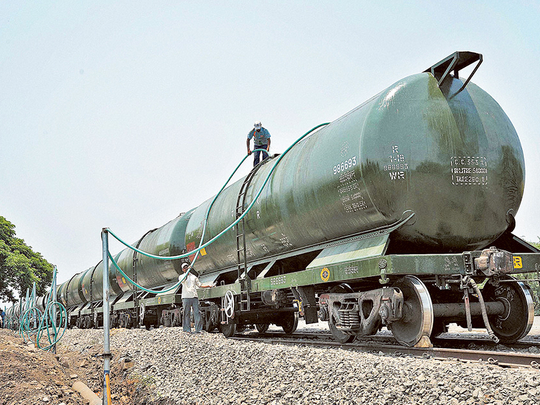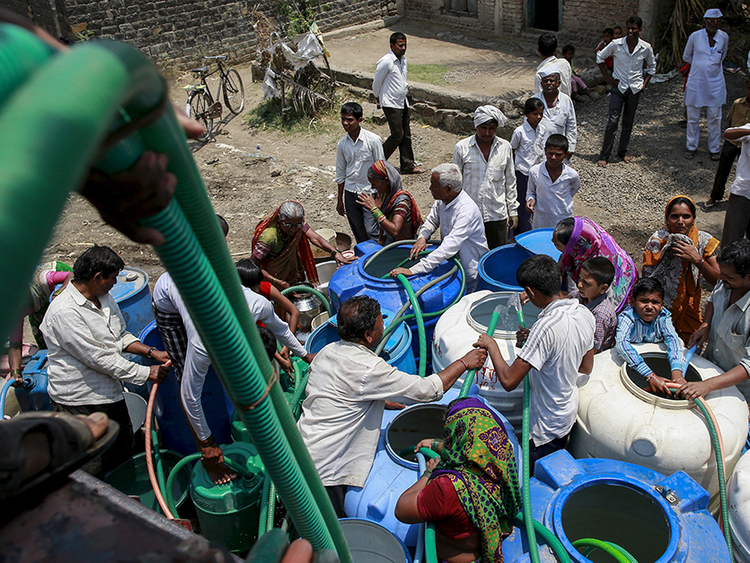
Latur, India: Haribhau Kamble, an unemployed labourer in India’s richest state, Maharashtra, is forced to queue for hours in scorching heat to fetch water even as the government puts on trains to ship water to the region parched by back-to-back drought years.
Like Kamble, millions of Indians have been hung out to dry in the state with the worst drought in four decades ravaging crops, killing livestock, emptying reservoirs and slowing hydroelectric power output. Mismanagement of water resources, with powerful politicians pushing for bigger supplies to industries, have made the situation worse, experts say.
“The government says it is bringing water by train every day, but we are getting water once a week,” Kamble said, after standing in line for three hours to fill two pitchers at a tap in Latur district, 500km southeast of Mumbai in drought-stricken Marathwada region.
New Delhi estimates that overall 330 million people are currently affected by drought across the country. (Image Credit: Reuters)
Locals had been hoping a 50-wagon daily water train would ease shortages, but they were disappointed as the 2.5 million litres carried by the train and ferried by tankers to villages was not enough to meet the needs of Latur’s half a million people and Marathwada’s 19 million.
Marathwada, home to many sugar mills in Maharashtra — the nation’s top producer — is one of the several regions in India that received below-average June-September rains in 2015. New Delhi estimates that overall 330 million people — a quarter of the country’s population — are currently affected by drought.
Water is set to get scarcer over the next two months as temperatures soar above 40 degrees Celsius, drying up Marathwada reservoirs that are now just 3 per cent full.
“That Maharashtra would face a water crisis was clear when monsoons failed, yet the state took no action to curb supplies to water-guzzling industries like beer and sugar,” said Parineeta Dandekar, associate coordinator at the South Asia Network on Dams, Rivers and People.
“There are limits on how much water the government can supply by train. Had it reserved water sources for drinking last year, the situation would have been much better now.”
A rapid expansion of sugar cultivation has made matters worse. Cane accounts for 4 per cent of Maharashtra’s crop area, but devours two-thirds of its irrigation water.
Water is set to get scarcer in Latur over the next two months as temperatures soar above 40 degrees Celsius. (Image Credit: Reuters)
Also, given politicians have stakes in sugar mills and other industries, there is a growing concern they may try to ensure water supply for their ventures.
Pankaja Munde, a state minister from Prime Minister Narendra Modi’s Bharatiya Janata Party (BJP), whose husband is a director of a distillery in Aurangabad, Marathwada, has said the liquor industry should get all the water allocated to it.
Munde did not respond to text messages seeking comment.
The Aurangabad bench of Bombay High Court, however, on Tuesday asked Maharashtra to halve water supply to liquor firms immediately and cut supply by another 10 per cent from May 10.
Residents hold plastic hoses as they wait for the government-run water tanker in Masurdi village, in Latur district, 500km southeast of Mumbai. (Image Credit: Reuters)
Eknath Khadse, Maharashtra’s agriculture minister, said the state was also planning to restrict cane cultivation and propose a five-year ban on new mills in Marathwada to conserve water.
At the centre, Modi’s government is focusing on managing watersheds and linking rivers to move water to dry regions to combat the crisis in India, which has 17 per cent of the world’s population but only 4 per cent of fresh rain water resources.
But the need of the hour is smaller, cost-effective steps such as enforcing restrictions on water use and ensuring canals do not leak.
“Canals are leaking everywhere in Maharashtra. Only a third of water released from dams reaches farms,” said Pradeep Purandare, a water and irrigation specialist from Aurangabad.
“There is complete mismanagement of water resources.”













